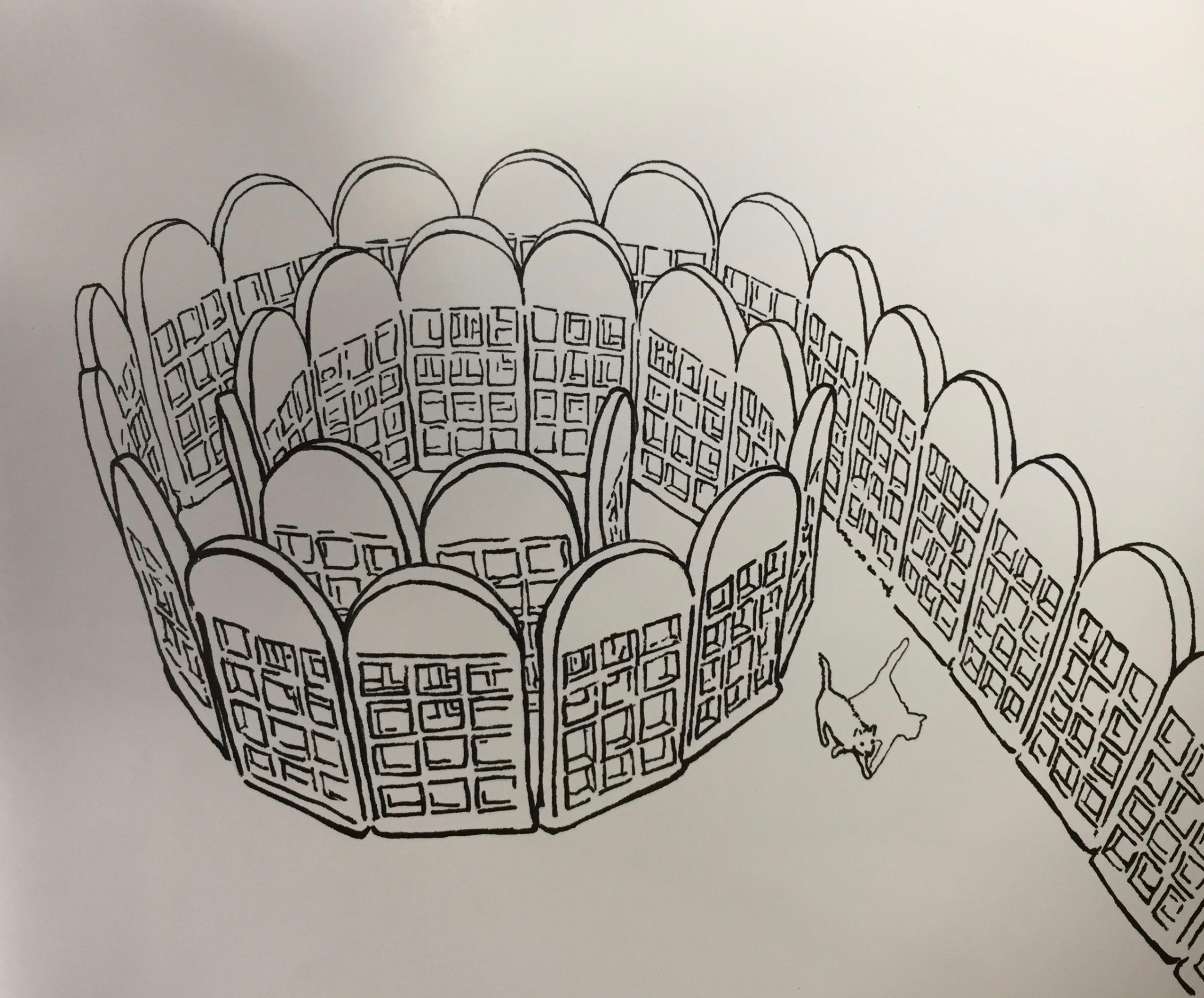If you missed part one, click HERE
If you missed part two, click HERE
If you missed part three, click HERE
Track 12 (“Complexion [A Zulu Love]”). Kendrick, on GKMC’s “Hol’ up,” is a “Gemini screaming for help.” Gemini, represented by twins, is associated with a complicated, conflicted, “many-sided” nature. Kendrick repeatedly refers to his hypocrisy, but what he has done in the evolution from good Kid m.A.A.d. city to To Pimp a Butterfly, is show how that hypocrisy is part of a continuum. These conflicted feelings are part of being human. Wavering between different opinions or lifestyles occurs on a daily basis at the same time that opinions gradually shift along the arc of a lifetime. That Lamar’s protagonists seem conscious of this contradictory nature makes Lamar a less problematic figure than Tupac, and the fact that Lamar came after Tupac gives hip-hop fans a point of reference to facilitate appreciation of Lamar’s potentially conflicted message.
Kendrick Lamar tells all the stories. That is one sense in which I see Kendrick learning from Tupac. Kendrick is more sophisticated than Tupac, I would assert. That sophistication may be a result of his coming chronologically after Tupac, who taught Lamar the power of diverse stories while enumerating some pitfalls that accompany goals of lofty storytelling. On songs like “No Make-up (her vice),” and “Tammy’s Song,” the diversity of Lamar’s message can be appreciated. Lamar reaches out to a diverse audience and speaks to a set of diverse social issues. Lamar’s voices and his contradictory nature seem mostly self-imposed. To understand Lamar’s motivation for imposing a label of ‘conflicted’ upon himself, the only choice is to continue moving through the album to its completion.
Track 13, (“The Blacker the Berry”). Misunderstandings of Kendrick Lamar seem less oppressive than they were for Tupac. At this point–track 13–in TPAB, Lamar launches into a track that is titled after the first lines from “Keep Ya Head up,” one of Tupac’s most popular, profound, and heart-felt tracks that begins with the lines: “Some say the blacker the berry, the sweeter the juice. I say the darker the flesh then the deeper the roots. I give a holler to my sisters on welfare. Tupac cares, if don’t nobody else care.”
Lamar’s track, “The Blacker the Berry,” references Tupac and this more explicit reference signifies a shift in TPAB. The final four songs come unencumbered by the refrain that has, until this point in the album, acted as an expanding and evolving chorus. The “conflicted” refrain disappears, but these songs seem more conflicted than the rest of the album, and the sequence culminates in the first recital of the complete chorus. The chorus, listeners ultimately learn, is a poem called “Moral Man.” Not only is the refrain a poem, a piece of spoken word, largely un-rhyming, that acts as the chorus to a rhyming record, but it is prelude to a revelation. At the end of the final track, listeners learn that they have been eavesdropping. Kendrick is reading a poem to Tupac and listeners have been overhearing that reading alongside an album-long ode. The last listening of the album is to a conversation between these two artists.
Track 14, (“You Ain’t Gotta Lie [Momma Said]”). Before arriving at the conversation between Tupac and Kendrick, Tupac had to be disentombed.
Tupac, prolific artist that he was, used intros/outros often and in distinct, confrontational ways. On “Picture me Rollin,’” Tupac calls out the district attorney during the outro, and on “To Live and Die in LA” he starts off with ‘sound clips’ featuring a reporter slash critic interviewing a ‘person-on-the-streets.’ That interview exemplifies the ideological and critical divide that Tupac represented. The reporter colors her questions by prodding the interviewee (who clearly likes Tupac)–after he says “I love Tupac’s new record”–by ‘asking’: “don’t you feel like that creates…uh.. tension between east and west?… he’s talking about killing people… ‘I had sex with your wife’ and not in those words…”
The tension around Tupac’s music was heightened on the album All Eyes On Me, which opens with Pac speaking, followed immediately by a sound bite that is infamous for initiating boxing matches: “Let’s get ready to ruuuuumble.” Tupac’s “Let’s get ready to rumble” introduction was real. It may have sounded funny or kitschy, but it was real. Tupac’s life started to rumble most passionately around this album. All Eyes on Me (AEOM) was one node that Tupac’s life, and the “contradictions” of his character, revolved around.
Tupac had contradiction in him from the earliest stages of his career, long wavering between “Keep Ya Head Up” and “I Get Around.” Tupac’s wavering between selves defied the sterile uniformity of a Freytag’s Pyramid character development arc. And that messiness is more deprecated by critics of ‘real’ characters than critics of fictional ones, where such novelistic liberties are often considered unrealistic.
That wavering aside, no turn in Tupac’s life was more pronounced than the turn that the AEOM focal node represented. To appreciate the gravity of events that precipitated that turn, consider: Tupac was shot–and nearly killed–in a recording studio. Regardless of whether–as different accounts have at different times claimed–it was orchestrated by Puff Daddy or Biggie Smalls, or someone else, or nobody, being shot in a recording studio must have felt, symbolically, like music was betraying him. Music was the thing Tupac was most dedicated to and it shot him. Soon after, society betrayed him, as evidenced by his sentencing on sexual assault charges. Then he was further disgraced by not having enough money to pay his own bail after all the music he made and all the touring he did. Suge Knight bailed Tupac out of jail on the condition that he sign with Death Row records, and on All Eyes on Me–the first album released after his release–Tupac came out of his corner swinging.
All Eyes on Me felt, to me, as though it were the beginning of the end. Tupac was going all-in on violence and aggression. As good as hip-hop’s first double album was, and as well as it sold, it was an angry album. AEOM’s song to women, “Wonda Why They Call You Bitch?” was even angry. It is a great song, but ‘yeah, well it’s your fault they call you bitch, because you kind of are one…’ is not pro-female in the same way that “Keep Ya Head Up” was.
“Only God Can Judge Me,” the most important statement on AEOM, seems an unsurprising refrain from a man on bail for sexual assault. Tupac effectively says: “America judged me, and the critics will continue to judge me, but I know the truth, so FUCK EVERYONE that fails to see that truth.” Tupac’s reactions could be those of a guilty man lying, or an innocent man flummoxed by the disbelief surrounding him. Or it could be both. Contradiction.
Juxtaposing “Only God Can Judge” with “Wonda Why They Call You Bitch?” highlights that “contradictory” nature of Tupac. Both tracks come from AEOM, but the morals seem incompatible; only God can judge that woman you are judging as a “bitch,” Tupac.
Tupac had turned over a new leaf. Or, rather, he embraced and embellished certain parts of his persona. He began flaunting his “2 of Americaz Most Wanted,” ‘thuggish’ side. Whether that decision smacks of guilt or innocence is irrelevant. The relevant point is that Tupac is generally portrayed as choosing to empower his “thug,” a character aspect Tupac dominantly displayed going forward.
On trial, being judged and labeled a “thug”–when he had long worked to provide positive and uplifting messages–was an egregious offense and Tupac’s reaction was AEOM. Rather than fight to remain uplifting or to become a more positive figure, he finally resigned himself to the charge to embody the caricature that had been made of him. Perhaps he finally accepted that role because he felt he couldn’t give any more positivity than he had already given, or perhaps he felt positivity was futile, or perhaps he was too tired to fight the judgment the world had passed, or perhaps he felt that since his musical attempts at positivity had failed and the work he saw himself doing wasn’t reinforced by or reflected in the media and with uplifting music failing to garner enough money to fight criminal charges, he accepted his new role with the same energy he brought to all of his endeavors. He took on a persona befitting the American media’s label of Tupac as ‘committer of sexual assault.’ America wanted Tupac to be a thug. America peer pressured Tupac into embodying the caricature it had made of him in courtrooms and in the media. America wanted a thug capitalist, not a socially aware rapper. Rather than fighting stereotypes, being political, and living poor, he resigned himself to being a thug, collecting and spending money with Suge. Accepting psychological imprisonment via stereotyping was the only way for Tupac to remain physically free. The industry was denying Tupac’s appeal to be accommodated on his terms, so Tupac played the hand he was dealt. He got on Death Row.
Track 15, (“i”).
The person Tupac believed in with the most conviction was himself, was “i.” That’s the moral of “Only God Can Judge Me” and the moral of Tupac, as a person. If I am allowed to say something as absurd as that.
I have an “Only God Can Judge Me” tattoo because I wish I had Tupac’s conviction and belief in self. I’m sure it wasn’t easy to maintain that conviction. It isn’t easy for me and I’m not at the top of the Billboard charts. Sometimes my memories are clouded and I can’t recall whether something really happened or whether I misfiled a dream under “old memory.”
That’s where my dream-memory comes from, some part of my mind, my memory, that is inaccessible to even me. Dream-memory is the contradiction of my own brain, crossing signals and getting convoluted. How can I maintain the conviction of ‘voice’ with all the different memories and voices flitting through my mind, making wrong turns and forming chimera memories? Do these chimeric memory-monstrosities spawn more often in famous people whose lives are being perpetually retold to them and for them by thousands of critics and ‘news’ outlets? Is it possible to stay centered and focused with the whole world pushing, pulling, and clawing? Everybody wants a piece and everybody has a read and everybody knows everything. On “How Do You Want it?” Tupac says: “Media is in my business and they actin’ like they know me.” At some point, do third parties claiming knowledge of your self begin conflicting and clouding your knowledge of self?
Where did the media get their information? Does fame, at a point, force some celebrities to start wondering if slanderous stories about them are true? How can a celebrity maintain a sense of self? Where is “i” when videos and news and quotes unwind this mortal coil, stringing it around the world, attaching it to events and places unknown? Tupac maintained his “i,” but it came at a great price. Tupac apparently sacrificed aspects of his vision to maintain the platform he had, the platform that enabled him to continue articulating his music with his message. Tupac tried balancing contradictory voices to continue making money while communicating a message, but the price of adapting to circumstances led him afield of his own message, and led to his death. The violence that Tupac’s caricature-self portrayed–imagining it would allow him to make money in order to live and continue sharing his message–killed him.
Track 16 (“Mortal Man”). I’m still here offering opinions on Tupac. I’ve waited this long to write anything about this hero of mine because who am I? I didn’t know Tupac. But then Kendrick Lamar imagined and actualized an interview with Tupac and–along with the emotions that were stirred inside of me–I realized I had to discuss these two heroes. Lamar accidentally told me I was allowed to talk about Tupac, so I am, but I promised myself I wouldn’t pass judgment.
Tupac receives, to this day, much criticism for his contradictory selves. Tupac was telling the stories he saw and felt the need to tell. The stories we must tell aren’t always the most flattering and aren’t always the easy ones to tell. That’s something Tupac, Kendrick, and James Baldwin each show me in different ways. How can you be prolific, honest, and meaningful without telling all the stories you feel need telling? How can you maintain a conviction in yourself if you subdue parts of your self?
In the interview at the end of “Mortal Man,” Tupac talks about life as a black man in America: “In this country a black man only have like five years we can exhibit maximum strength. And that’s right now while you a teenager, while you still strong or you still wanna lift weights, while you still wanna shoot back. ’Cause once you turn 30 its like the take the heart and soul out of a man–out of a black man–in this country… and if you don’t believe me you can look around, you don’t see no loud-mouth 30 year old mothafuckas.” Tupac refused to go quietly. He was being a loud-mouthed motherfucker ’til the day it killed him. But he was being honest and showing the world what he felt America beating into him. He was living, honestly living, the caricature he saw America drawing of a young black male. Sometimes that was a young black revolutionary. Sometimes that was a person who respected and loved women. Sometimes that was a horny young man surrounded by women in bathing suits showing up at casting calls for rap music videos. Eventually that was the man who started to believe he was “Trapped” as he rapped on his first album. And with no way out but down, down he went. Swinging.
Tupac told all the stories. He told them with one of the most listenable and accessible deliveries in the history of hip-hop. Tupac always rapped in his voice so “all the stories” sometimes sounded contradictory. To hear all those stories from one person isn’t unheard of, but it is rare in music, and rarer still in hip-hop. Tupac told many stories and lived many lives. As we all do, if we are honest.
That is one take-away of To Pimp a Butterfly: storytelling stretches one person’s story and one person’s experience beyond the confines of mortality. Consider how one mortality can stretch to encompass Kendrick Lamar’s entire ethos. It might not have mattered whether, as Lamar mentions on the outro of TPAB’s final track, Lamar had called the album’s refrain–the one that “ain’t really a poem”–“Another Nigga,” “Mortal Man,” or “To Pimp a Butterfly.” The most important thing for listeners to realize is that all those possibilities are floating through the stanzas of that poem and the bars of this album.
“I remember you was conflicted
misusing your influence
sometimes I did the same.
Abusing my power
Full of resentment
Resentment that turned into a deep depression
Found myself screaming in a hotel room
I didn’t want to self-destruct
The evils of Lucy was all around me
So I went runnin for answers
Until I came home
But that didn’t stop survivors guilt
Going back and forth, trying to convince myself the stripes I’d earned
Or maybe how A-1 my foundation was
But while my loved-ones was fightin’ a continuous war back in the city
I was entering a new one
A war that was based on apartheid and discrimination
Made me want to go back the city and tell the homies what I learned
The word was respect
Just because you wore a different gang color than mines
Doesn’t mean I can’t respect you as a black man.
Forgetting all the pain and hurt we caused each other in these streets,
If I respect you, we unify and stop the enemy from killin’ us.
But I don’t know, I’m no mortal man.
Maybe I’m just another nigga.”
And it is here that the album and this essay–like an album music is sometimes imprinted on–comes “full circle.” The album comes back to Tupac. And my giddy smile turns into tears. I am crying at the end of this album. Every time I listen to it. Crying. Tears of joy. Hypocrite.
Hypocracy’s cousin, ambiguity, lingers around the final track of the album. It is unclear what part(s) of TPAB is meant to be interpreted as an attempt at a conversation with the dead rapper Lamar idolizes. Is the refrain– the one that “ain’t really a poem”–the only part of the album that is being spoken directly to Tupac? or is the whole album, including that refrain, being theoretically spoken to Tupac? Making listeners think about it might be the most poignant intention. Regardless, this is where it ends, with Tupac.
More precisely, To Pimp a Butterfly ends with Tupac disappearing as Kendrick Lamar calls after him. With Lamar begging for a response, for an answer. An answer from a ghost.
Several months after writing some initial thoughts, thoughts I felt, preternaturally, were connected to Kendrick Lamar–thoughts about the Sistine Chapel and about Calvin and Hobbes–I learned that the creator of Calvin and Hobbes, Bill Watterson, painted the Sistine Chapel on the ceiling of his Kenyon College sophomore-year dormitory. I didn’t know that until after I laid the thoughts down as ‘tracks’ one and two of the final draft of this essay. Someone who read this essay shared that information with me. That revelation reinforced my decision to put those pieces together and confirmed for me that sometimes disparate art forms and artists collide across time and space.
I hope readers will be struck as abruptly and honestly by that connection as I was. I hope that realization is felt by readers as starkly as a different convergence that has been impressing itself upon me, delaying the posting of Part 4 until it could be “fleshed” out.
While I never intended for Kendrick Lamar, Tupac Shakur, and Roland Barthes to converge, I see now that they have. And while they needed me to do the introductions, to trace the thoughts and lives of each in order to recognize all that they have in common, it was there for anyone to see.
When I say that Barthes, Tupac, and Lamar collide, I am talking about one book of Barthes’ in particular, S/Z. S/Z is an essay by Roland Barthes wherein Barthes creates a universal method for analyzing narratives and then deploys that method in order to demonstrate the impossibility of creating a universal method for analyzing narrative. If that sounds paradoxical, pedantic, excessive, or self-aggrandizing, it may be. It is also a remarkable essay.
S/Z is an epic and it is the very thing it is supposedly about. My favorite piece of poetic criticism, as reported to me by a professor, was that The Wasteland by T.S. Eliot ushered in a new era of poetry by being what it was about. The poem is a wasteland. S/Z, like The Wasteland, is a rare work of art transcending its medium by becoming the thing it seeks to represent.
S/Z uses Sarrasine, a 33-page short story pulled from the depths of the oeuvre of Honoré de Balzac, as its object of criticism. S/Z winds and wanders, deliberately, through hundreds of notes, quotes, unpackings, and digressions. Then it presents the full text of the story Sarrasine, the little-known story that Barthes uses as object for this exercise. It is unlikely that readers of S/Z are familiar with Sarrasine, but Barthes doesn’t seem to think that is important. The story is afterthought to the essay that critiques it. While google searching Sarrasine, Barthes’ essay is mentioned in the first sentence of the first search result. Seldom, to my knowledge, has a piece of criticism supplanted the literature that it is discussing.
S/Z is an intense, focused, scientific examination on the scale of a super-powered microscope. S/Z reminds readers of how much is missed in a casual reading and even in a ‘close’ reading. Barthes’ universal method used to dissect the 30-page short story Sarrasine yields an essay that is over 200 pages long. And that is only a partial revealing of Barthes’ one viewpoint. The length and profundity leaves readers wondering. Wondering whether the ‘point’ of reading is to mentally conjure every detail and achieve synchronicity of conscience with the writer, or what the purpose is of reading one critic’s one viewpoint on another writer’s story could be, or why reading a critic’s reading ought to carry more than one’s own reading, or what the double-filtration of reading a critic’s reading does for readings of the ‘classic text.’ Could such a ‘tool’ for analyzing the “classic text” reasonably be used to analyze a ‘classic’ like The Iliad and its approximately six-hundred-pages of content? What would that yield?
Barthes announces that use of the type of analysis found in S/Z starts with a “classic text.” Sarrasine, however, is an unheard-of text supplanted by its criticism. So although Barthes may or may not condone it, I have been liberal in defining “classic” and “text” during my vaguely Barthesian reading of To Pimp a Butterfly. Before moving back to TPAB, we must consider where S/Z, this book of unwieldy, obnoxious, relatively epic proportions, finishes. After the dissection and interrogation, what knowledge are readers left with? This is from the final paragraph:
“the classic text is pensive: replete with meaning (as we have seen), it still seems to be keeping in reserve some ultimate meaning, one it does not express but whose place it keeps free and signifying: this zero degree of meaning, this supplementary, unexpected meaning which is the theatrical sign of the implicit, is pensiveness: the pensive is the signifier of the inexpressible, not of the unexpressed. For the classic text has nothing more to say than what it says… Just as the pensiveness of a face signals that this head is heavy with unspoken language so the (classic) text inscribes within its system of signs the signature of its plenitude: like the face, the text becomes expressive (let us say that it signifies its expressivity), endowed with an interiority whose supposed depth compensates for the parsimony of its plural. At its discreet urging, we want to ask the classic text: What are you thinking about? but the text, wilier than all those who try to escape by answering: about nothing, does not reply, giving meaning to its last closure: suspension.” (216-217)
This paragraph, and all of S/Z, is bursting with valences of meaning that I see tethering themselves to Kendrick Lamar, TPAB, and Tupac. For all of my unpacking and paraphrasing and interpreting, TPAB has nothing more to say than what it says. That is why I hope this writing has forced you to listen to the album or forced you to re-listen to the album. The album says it all, even if some interpreting and slowing down aids digestion. The videos add layers of complexity to the songs, but the listening is where everything begins and ends.
And there is Tupac, who is “endowed with an interiority whose supposed depth compensates for the parsimony of [his] plural.” Tupac, in life, but most vividly in death, is “endowed with interiority whose supposed depth” has been rejiggered, remastered, re-invigorated, made hologram at music festivals, reinterpreted, and re-represented. These posthumous re-imaginings attempt to compensate for the “parsimony of [his] plural.” I read that phrase, parsimony of his plural, and it begs me to start pulling threads together and forming a rainbow spool of LamarShakurBarthes, thereby noting the “conflicted” “duality” of Tupac as referenced by Lamar. Duality is as parsimonious as plurality can be, if my math is correct. The dual nature of Tupac as portrayed on TPAB unifies these characters, these ‘objects.’ TPAB and Tupac are herein being criticized as Barthes might have done. These character-objects (Lamar’s TPAB, Tupac, and Barthes) are perpetually interrogated elsewhere in the media, and at critical moments each is nearly overtaken by the immense quantity of criticism they merit.
Tupac has yet to get obscured, and neither will TPAB, even beneath years of critical dust, and the nature of Barthes’ work kept his celebrity distinct from his ‘self’ thereby distancing Barthes from such masses of criticism (though lackluster attempts exist). Perhaps, along with or because of the pensiveness at the heart of these ‘classic’ text\objects, none of them can be overshadowed by their criticism. Perhaps that is the sign of the classic text, that its criticism can never reach it. Each ‘text’ retains its integrity by remaining polarizing, pensive, un-signified and unfinished.
At the end of Kendrick Lamar’s album, I am watching Tupac exit again. As much as that departure upsets me, I finally understand that his refusal to respond mirrors Barthes’ “text that is wilier than thou.” The needle runs out of vinyl to tread on and I sit, waiting, beckoning; “Pac… Pac…Pac” and all that I receive in response is the sub-sonic hiss of an album at its end that nevertheless spins on, producing beyond its final punctuation









Wow. Beautiful. Powerful. Gripping. I learned much reading this. This 4th part brought the most insight and clarity for me.